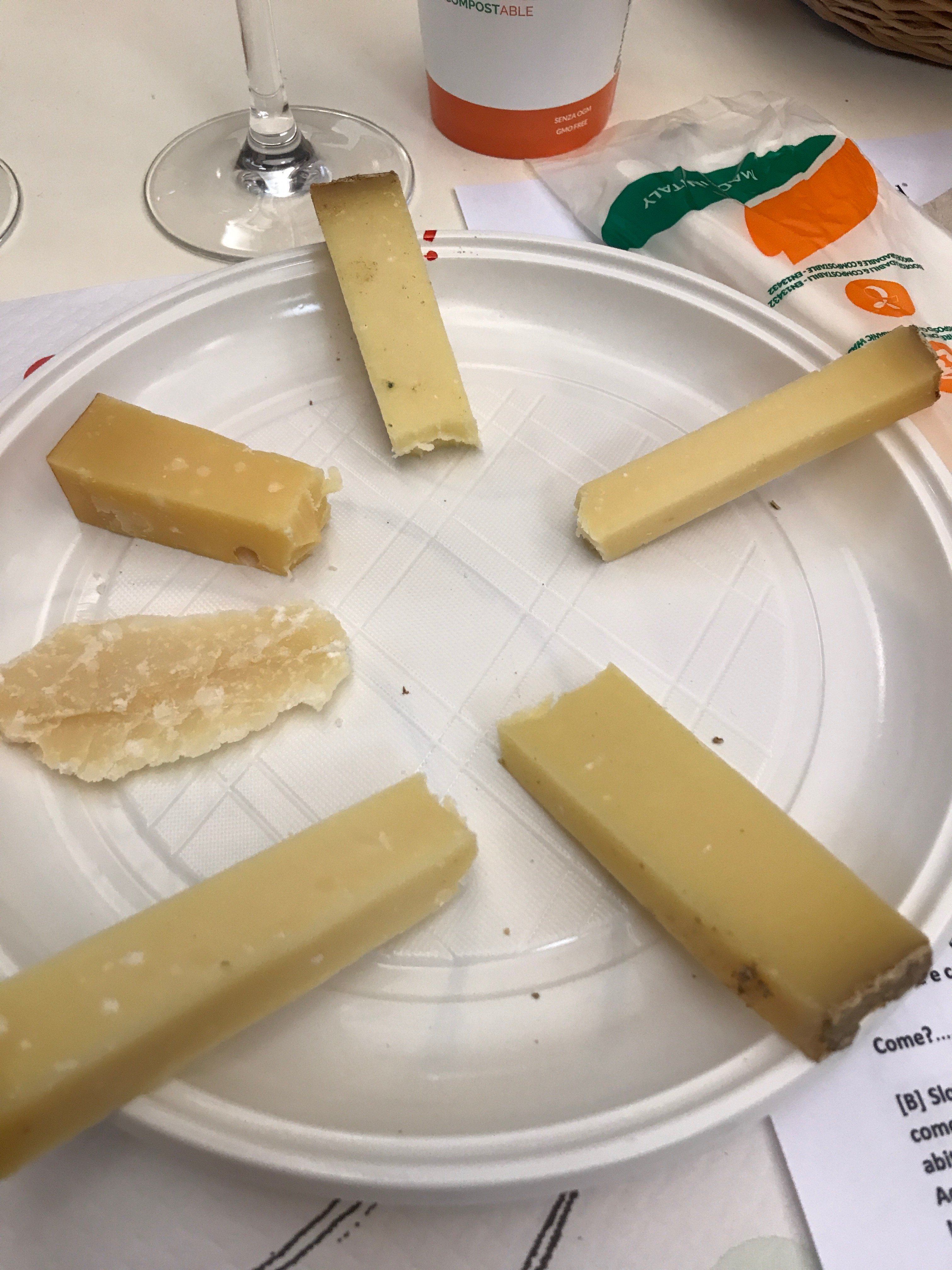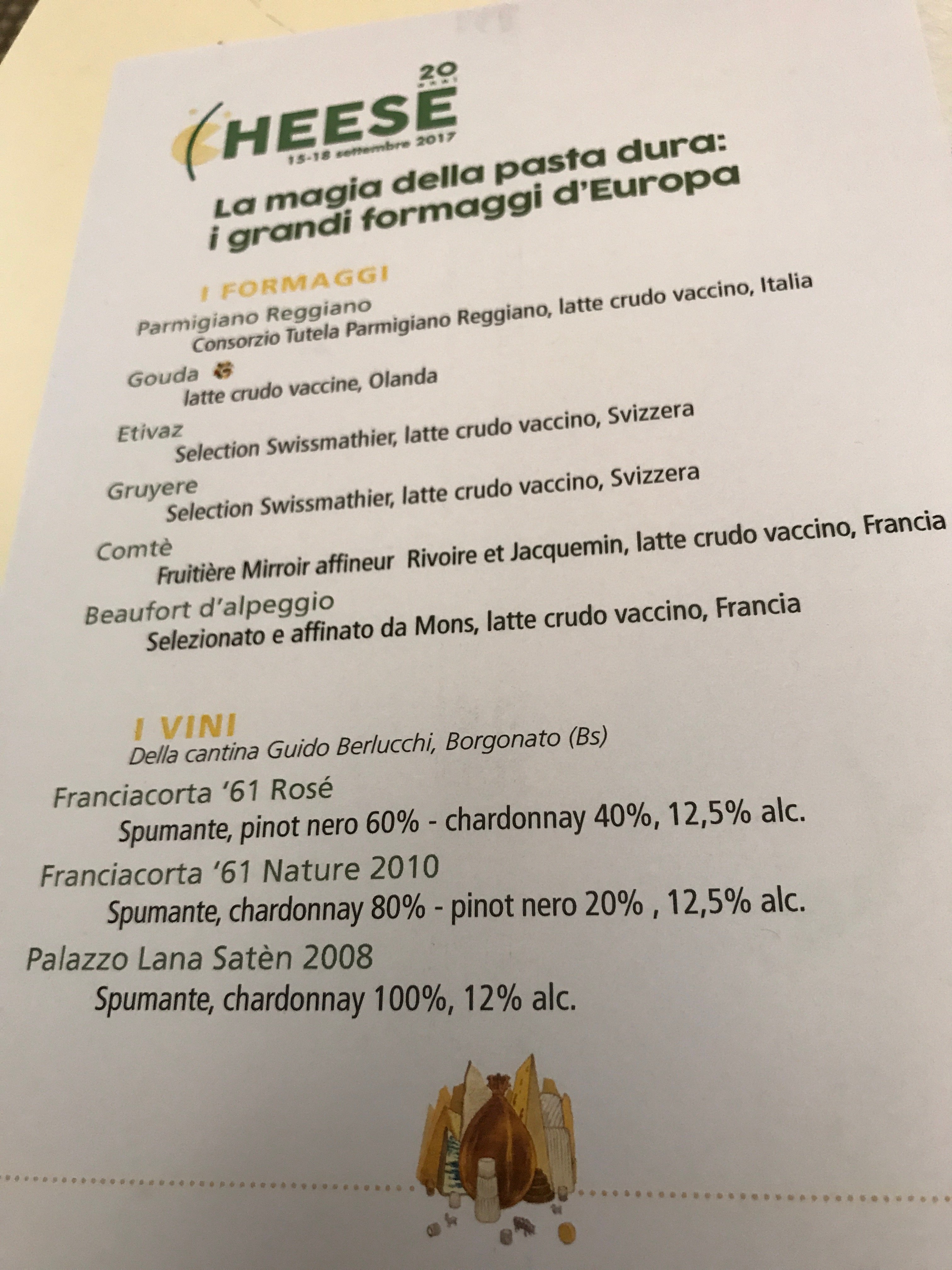The last day of Cheese 2017 in Bra I was lucky enough to participate in a guided tasting of some fine European firm cheeses. The tasing was proficiently led by Hervé Mons. Firm cheese is exciting, even though I know a lot find them boring, at least when that’s the sole type of cheese on the plate. But there is a lot of taste, aroma and nuances you normally don’t think of, unless you really sit down to taste.
All the cheese on the plate was made during August 2015, so they were 25 months old. A bit of confusion on my part regarding the Parmigiano Reggiano which I think was mentioned to be 48 months old. The rest were definitely 25 months.

The six cheeses
If you look at the picture above and start at 12 noon, the first one is a Beaufort d’Alpage. From Savoy in the eastern France. Normally produced from June through October, this particular one in August. 2017 season has been shortened by a month, though, due to cold weather and early snow in the mountains. Mid September the herd was back down in the valley. Pleasant smell of milk and herbs. Pale yellow paste and compact texture with no holes whatsoever. Mild taste with a hint of sweetness and hazelnuts. Melts in your mouth. This cheese has been matured by Mons.
We had a Franciacorta ’61 rosé NV, sparkling wine to go with it. 60% Pino Nero and 40 % Chardonnay. If I am about to drink Italian sparkling wine I’d rather prefer Franciacorta. It paired well with the cheese and cleaned up my palate pretty well as Beaufort has some butterfat. The same sparkling wine was also served along the Swiss Etivaz, provided by Swissmathier who I know pretty well. Etivaz is Beaufort’s cousin and comes from the area to the east of Montreux. Fruity aroma and taste. Firm and compact texture, with no holes. Pale yellow paste. The cheese has started to develop crystals. Feels somewhat saltier that Beaufort. This Etivaz is, by the way, made in wooden vats.

Swiftly back to France for a Comté from the Jura. Have had better Comté I must admit. Firm and compact texture as it should be, color is fine as well, but the taste does not lift me up. From the cooperative Mirroir and matured by Rivoire et Jaquemin. This was paired with Franciacorta ’61 Nature 2010. 80 % Chardonnay and 20 % Pinot Nero. A step up in quality for the wine, if not the cheese. I think Hervé Mons realized we should have started with this cheese.
The Comté was followed by a Swiss Gruyère, also from Swissmathier. If you’re after prime Swiss cheese, contact Swissmathier. Light yellow color. Texture is compact and firm with no holes. Crystals. Creamy once you have a bite and a wonderful taste of hazelnuts on the palate. Gruyère oftentimes have a discrete smoke aroma because the cheese is made in vats heated over open fire (when the curd is “cooked” with the whey).
Up next is cheese number five, a Parmigiano Reggiano from Consorzio Tutela Parmigiano Reggiano. 48 months, I assume that’s what they said. Artisan cheese this as well. A lot of the Parmigiano Reggiano made, is industrial. Does not have to be poor cheese for that reason, they all have to follow the rules. But additives are used by the industrial producers that small artisan producers would never allow. I am not on top of the Italian language, but I think they said there are 39 additives allowed due to clever lobbying from the industrial makers. None of these additives present in the cheese on the plate, though. A little dry for my taste. Not unusual for PR, but I also found the taste somewhat flat, compared to what I have tasted earlier. Not the sweet touch I had expected.
Finally
Dutch Gouda. Boerenkaas, which means it is a farmstead cheese. Unfortunately no information about the producer. Paste is pale yellow, but darker than the other cheeses present. Firm and compact with a few scattered holes and very distinct crystals. Sweet and with a walnut character. Long pleasant taste. Creamy. Best in show. Along these two last cheeses we had a Franciacorta
Palazzo Lana Santèn 2008 made from 100 % Chardonnay. I found the wine paired better with the Gouda than the Parmigiano Reggiano.
Tastings at Cheese 2017
If you plan on going there in two years, I definitely recommend to participate in the guided tastings. Many of them are open to the public and free as long as seats last, others by ticket only, but it is worth it. You should plan well ahead to get a room not too far away.

Which blog are you starting to write for, so I can read? If you want to write a post about English cheese on my site, you are more than welcome. I cannot offer you anything but goodwill and credit. My site is bilingual so I will translate into Norwegian. Feel no obligation or rush, though.
So what is it about cheese that make you so passionate?
I think the real passion begun at HT Webb. It was 2003 and Arla were buying the importer. I had a chance to deal with the transfer of products and that meant trying all the cheese, learning about selling it, manufacturing and processing it. Fascinatin. Even down to how delicate a stilton is to cut when you want to present rind on all portions.
When I go to resturant, never touch desserts, always the cheese board. In Krakov I persuaded a resturant to add the cheese selection to their evening menu. It was only an afternoon option. Mad, as after a delicate main, say seafood mousse and vegtables, with various souces, you end with a huge slab of chocolate Cake! Cheese doesn’t conflict with the complex tastes.
I also love the artisan processes and the husbandry of the animals. It’s cow country where I live, but beef, with them at the bottom of my garden.
My favorite cheeses are Spanish, it’s light on the stomach and I like the more acid taste of sheep’s cheeses than cow. I Romania, where my husband comes from, the fresh sheep’s cheese is heaven. Huge slabs in brine, so fresh.
I would love to write some guest posts. the blog I will be writing on is The Good Life In France – Janine Marsh writes a quarterly on line magazine. It’s a great opportunity for me as writing is what I want to do here in France. And it is cheeseland afterall 🙂
Yeah, that’s what I thought, The Good Life in France. I found it via your site, actually. And I wonder how you came across OstePerler (it means “cheese gems” by the way).
I actually handed in my resignation at the end of September. So when Christmas comes, I am on my own with my cheese. Not quite as adventurous as you are, though, moving to France. Really looking forward to spending more time with cheese, and hopefully manage to make some money from it as well. My wife’s corporate, so that’s the safety net.
I am off to Colmar, Alsace, this week-end with some friends. Not primarily cheese, rather more focus on wine, but I always have cheese in mind, set to find some I have not tasted before.
When you have the time, you are, as I said, more than welcome to contribute, being it English, Spanish or French cheese. It will not be read by the millions, but quite a few, over time.
I would love to write about cheese on your site. Like you I want to spend my “later” years doing what I love. I gave up working for others in 2006 and do not regret this. Re not many reading your blog – I think your blog is excellent and I think with your now full time commitment, readership will increase. I am just happy to participate and flex the writing muscles. I also photograph a bit. If you want some cheese photography I can do that too.
Much appreciated. Feel free to contribute. I am open to any suggestions, and by the way, I’m a lousy photographer.
Hi, Thanks for replying. I have thought about this, but only recently moved to France and tied up with trying to get straight, but the cheese issues is something I feel passionate about. I am actually going to start writing about French cheeses fro another blog, but try and sneak in a little about English ones along the way. Its so frustrating as the English cheeses complete a cheeseboard, as much as you would try to put in an Italian for salt, Dutch for heated and French for fatty. But isn’t that England all over – failing to capitalize on what they are good at!!
Thanks for reading and commenting. Much appreciated. I came home from Bra, Italy, with my back-pack full of English cheese. However, I think England has a way to go to tell Europe about your cheese diversity, because Europeans perceive English cheese as boring, firm and crumbly, only good for melting on a toast. That’s also by and large the perception I have had for years since I left university in Manchester back in 79. There is, however a lot happening in Britain, and that is why I brought home English cheese. Goat, cow, ewe. Wonderful cheese. Unfortunately, not much of it is available outside Britain. But why don’t you start importing British cheese to France, you seem to know the trade?
Why oh why do Europeans not eat English cheese! I have just moved to France and the choice of fatty, creamy French or rubbery Dutch is to be honest tiresome without some good English. I worked for HT Webb a cheese importer in UK and gladly shared European cheeses with my clients. Why isn’t this reciprocated in Europe? I am also glad the USA are coming on leaps and bounds with artisan cheese. But that is even more unlikely to hit French shores. Shame.